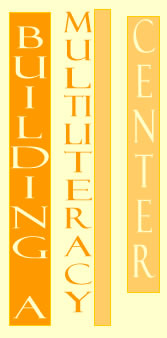

KHM: How did you interest that Art and Design professor and his
students to be involved with the Multiliteracy Center?
DS:
In the process of trying to recruit people from the School of Art and
Design, I was contacting professors saying, "Hey, would any of your
students be interested in this? Would you recommend that any of them get
involved in this program?" And I contacted a lot of the Art and Design
professors who were working in new media.
I happened to contact one particular professor who was interested in the
whole project and had actually written articles about things that were
related to it. Because he was interested enough in it, he agreed to teach
a version of our pedagogy course that was adapted for the needs of his
students. What that meant is that we developed a core set of readings
that focused on collaboration, on tutoring, on pedagogy that would be
familiar to anybody who works in a writing center. We had them do observations,
just like our traditional peer tutors do. They observed their peers tutoring,
they observed faculty tutors, and they led practice sessions themselves.
But in the formal writing that these graphic design students did for the
course, rather than write about writing-related issues in the narrow sense
of the word, they wrote about design-related issues, which overlapped
significantly, dealing with typography and layout, how text appears on
a page, and things like that.
KHM: Did some of that writing evolve into the manuals these art and design students created to assist non-design students working with visual communication?
DS:
Yes. As final projects for the course, the students worked on what they
called guides. Each guide focused on some issue related to multimodal
communication, whether it was navigation scheme, typography, color, the
relationship between photographs and text. They did extensive research
in the design literature, and they integrated and synthesized these areas
of focus, and put them into a form that a layperson could access. And
these eventually were redesigned as web pages that could be linked to
the Multiliteracy Center website to make them available to the university
community.
It was a good project for the students to go through. From
what I understand, graphic design is taught as a very practical, practice-oriented
way. You're in studio classes, you're working on projects and you're getting
feedback from your peers and your instructors, but there's not extensive
reading in the theory of design. There's some of that, but the Art and
Design class that we developed to train Multiliteracy Consultants allowed
these graphic designer majors to read more extensively in the literature
and the theory of design and visual communication than they otherwise
might have.
Top | Next